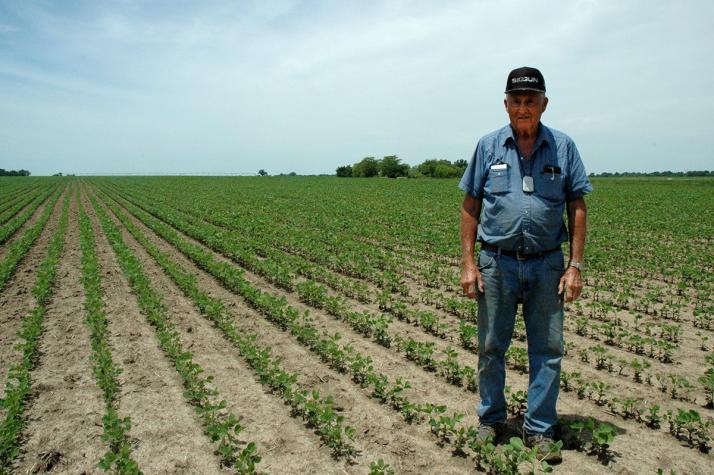Writer
Linda GeistBELLFLOWER, Mo. – You won’t find grass growing under 81-year-old Russel Winter’s feet. While many farmers his age are retired, Winter still likes to lead the way in trying new farming technology and methods.
During a recent hot summer day, Winter helped dig a trench for subsurface drip irrigation on his farm in Montgomery County. “I’ve been wanting to try this for 10 years,” he said. “Now that I should be quitting (farming), I’m trying it.”
University of Missouri Extension research finds that subsurface drip irrigation (SDI), when used as part of an integrated drainage water management system, can boost corn yields by 41 bushels per acre and soybean by 14 bushels per acre on poorly drained flat soils.
Winter built his own SDI unit for less than a third of the $7,000 cost of a ready-made applicator. He also designed and built a pump and filtering unit that supplies irrigation water from a 10-acre lake.
He uses conventional pivot irrigation on other parts of his farm. Installation and operation costs are about the same. The newly installed SDI is better suited for the 14-acre plot because pivot irrigation systems do not easily accommodate small, oddly-shaped fields.
System layout and design is based on the research of MU Extension agronomists Rusty Lee and Kelly Nelson. Water from the lake is pumped through a disk filtration system and distributed to drip tape through buried PVC pressure and flush manifolds.
In addition to higher yields, Lee found that SDI increased kernel size and improved test weight. All of this means better profits and less worry for the farmer.
Trying new technology allows Winter to adapt to changing markets. His cash-only financial practice, a holdover from lean times in the 1970s, gives him the freedom to take some risks.
In 1970 he was the first to double-crop soybean in Montgomery County, Winter said. “I got laughed at first. Three years later, my phone rang off the hook wanting to know what I was doing.” The first year, his soybean made 30 bushels per acre. The second year, he planted in 20-inch rows and produced 35 bushels per acre. The third year, dry weather trumped technology and beans made 5 bushels per acre.
He also started the first slatted-floor hog house in the area. He tried to save labor with a farrow-to-finish operation. When hog prices dropped to $30 per hundredweight, he moved efforts into more row-crop land. He helped organize and build the first ethanol plant at Macon and invested in the biodiesel plant at Mexico. He also pioneered the use of hairy vetch as a cover crop for erosion control in his area.
Winter follows outlook trends offered by MU Extension economists, including Abner Womack, professor emeritus of agricultural economics and co-founder of the Food and Agricultural Policy Research Institute (FAPRI). He is regular at Womack’s impromptu coffee gatherings with farmers in the Montgomery City area. He checks the weather each morning before planning his day’s work, and he monitors market prices hourly from his smartphone.
Last year, MU Extension held a session on subsurface drip irrigation at Lee’s Warren County farm. Researchers also demonstrated MU’s free Crop Water Use mobile web app (cropwater.org) to schedule crop irrigation. Winter couldn’t attend because he was receiving chemotherapy. When Winter’s treatment course was over, Lee volunteered to give individual training on how drip irrigation works.
In addition to offering more flexibility than pivot irrigation, drip irrigation also prevents wetting of crop leaves, reducing the likelihood of foliar diseases, Lee said. It can decrease water use by as much as 25 percent. Water-soluble fertilizers such as nitrogen can be applied through drip irrigation.
There are a few drawbacks, Lee said. Rodents can chew through drip lines, especially when the soil is loosened during installation. Water filtration requires frequent monitoring for particulates that could clog the emitters. Another concern is bacterial growth inside the drip tape, but this can be managed through acidifying agents.
Both surface and well water work with an SDI system, but an irrigation water-quality test is the first step in evaluating SDI for your operation.
For more information, contact your local MU Extension center or visit crops.missouri.edu/irrigation.
Photos available for this release:
https://extension.missouri.edu/media/wysiwyg/Extensiondata/NewsAdmin/Photos/2018/sdi0194.jpg
Bellflower, Mo., farmer Russel Winter uses his phone to track weather and the markets while helping trench a ditch for subsurface drip irrigation. Photo by Linda Geist.
https://extension.missouri.edu/media/wysiwyg/Extensiondata/NewsAdmin/Photos/2018/sdi0197.jpg
At 81, Russel Winter still likes to try new farm technology. He recently installed a subsurface drip irrigation system on an irregularly shaped plot of soybean. Photo by Linda Geist.
https://extension.missouri.edu/media/wysiwyg/Extensiondata/NewsAdmin/Photos/2018/sdi0198.jpg
Russel Winter, left, and MU Extension agronomist Rusty Lee, right, use subsurface drip irrigation (SDI) at their farms. They built their own trenchers for the drip lines, and Winter helped design the water pump and filtration unit for his SDI system. Photo by Linda Geist.


